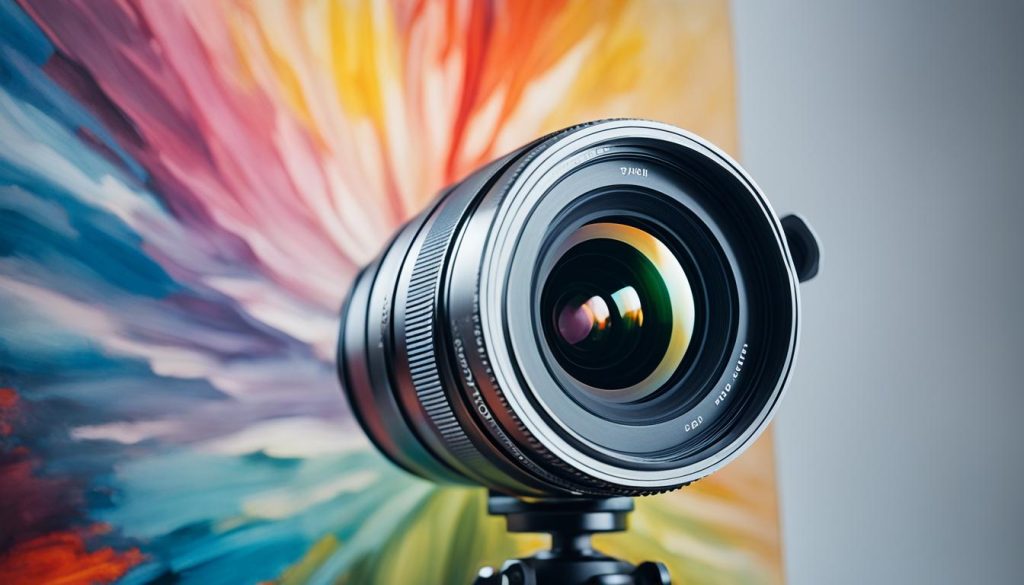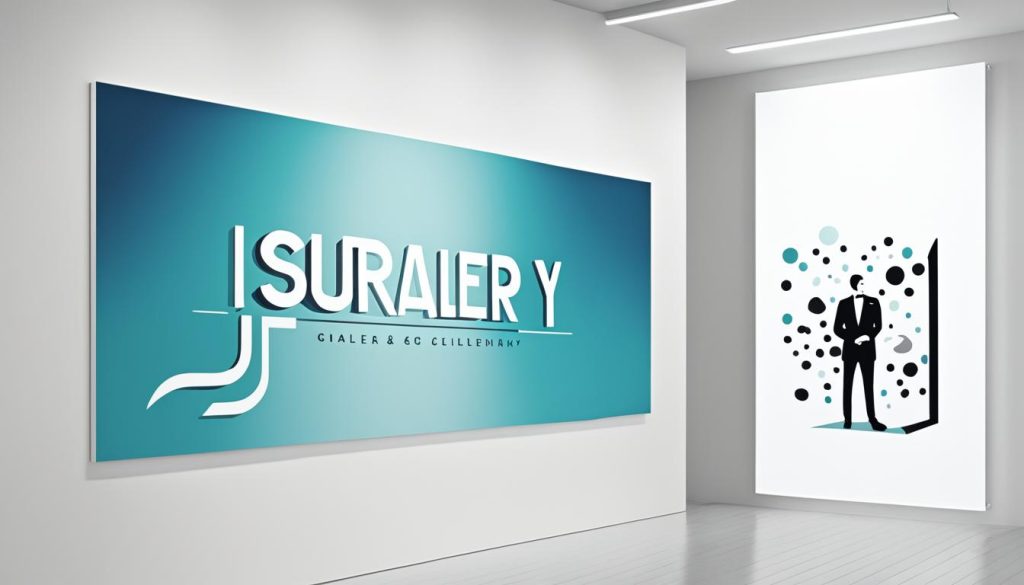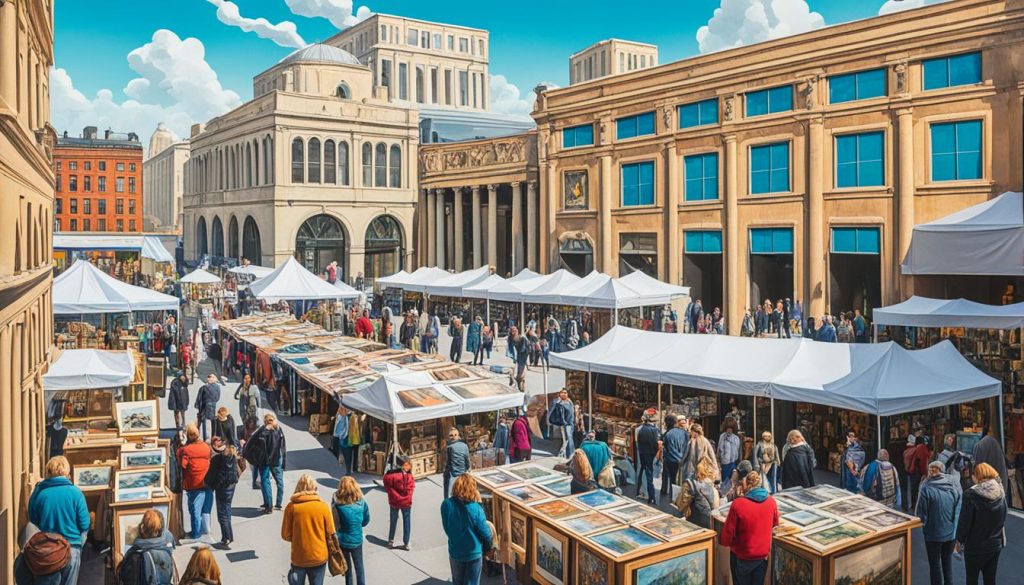Selling art online can be rewarding for artists. It lets them show off their talent to more people. But with many artists online, how can you stand out and make more money?
This guide will show you the best ways and places to sell your art online in the UK. It’s for artists who want to increase their earnings or those starting out in the online art world. You’ll get the key knowledge and tools to succeed in the digital art scene.
We’ll cover everything from picking the right business model and what to sell to building a strong brand and marketing your art. By the end, you’ll know how to make a successful art business in the UK. You’ll also learn how to increase your profits and reach your artistic goals.
Key Takeaways:
- Learn effective strategies to sell your art online
- Choose the right business model for your art business
- Decide whether to sell original art or reproductions
- Discover how to photograph and scan your art for online sales
- Find a reliable printer to produce high-quality reproductions
How to Sell Your Art Successfully
Selling art takes careful planning and the right strategies. As an artist, you have a unique vision and talent. By using the right methods, you can sell your art and make a mark in the market. Here are some tips to help you succeed in selling your art.
1. Establish a Pricing Strategy
Setting the right prices for your art is key. Look at the market to see what similar artworks are worth. Consider size, materials, and your experience when pricing. This way, you can draw in buyers and get fair pay for your work.
2. Build Your Brand
Having a strong brand is vital in the art world. Develop a unique style and keep making high-quality art that shows your vision. Show your work on social media, join local art events, and work with other artists to grow your network and reach more people.
3. Create a Professional Website
In today’s digital world, a professional website is a must for selling art online. Show your artwork in a neat and attractive way, include detailed descriptions, and make buying easy. Use keywords and update your site often to draw in more visitors.
4. Explore Different Channels for Selling Art
Don’t just rely on your website. Look into other ways to sell your art, like online marketplaces, art fairs, and galleries. Each place offers different chances to meet art buyers.
5. Partner with Galleries
Working with galleries can really help your art sales and reputation. Find galleries that match your style and approach them with a professional portfolio. Being in a gallery gives you credibility and a chance to meet art lovers.
Selling art well needs both artistic skill and business smarts. By following these tips, you can boost your art sales, make a mark in the art world, and achieve success.
Choosing Your Business Model

Artists have the freedom to pick their business model when selling art online. This choice is key to how they share their creativity or highlight others’ work. Let’s look at the two main options: selling your art or curating others’ work.
Selling Your Own Art
If you’re skilled in art, selling your pieces can be fulfilling. You can sell original artworks or reproductions, depending on your style. This could be paintings, sculptures, or digital art.
Original art lets you offer unique pieces for homes or offices. This way, you can share your artistic vision and creativity fully.
Reproductions, on the other hand, help you reach more people. Quality prints, like giclée, capture your art’s details and colours. This lets you sell more art without losing quality.
Curating Art from Other Artists
You don’t have to sell only your art online. Many artists curate art from others and become art connoisseurs. This way, you can show different styles and connect with more artists and collectors.
As a curator, you pick art that fits your taste and your audience’s likes. You support other artists and make money from their sales too.
Curating art lets you build a platform that shows your taste and helps others discover art. It’s a way to share your vision and grow the art community.
Think about what you love, know best, and aim for when picking a business model. Whether it’s selling your art or curating others’, make sure you stand out online. Use this chance to share your creativity and help grow the art world.
Deciding What to Sell: Original Art vs. Reproductions
Artists often have to choose between selling original art or reproductions online. Each option has its own benefits and things to consider. Knowing the differences can help artists make choices that fit their goals and audience.
Original Art
Original art is unique and can’t be made again. It includes paintings, drawings, sculptures, and illustrations. Selling it lets artists show off their talent and creativity. Each piece is special, making it sought after by collectors and fans.
Collectors who value an artist’s skill or feel a connection to the art pay more for originals. This can be a great way for artists to earn more. But, making originals takes time and materials. It also means artists can’t make many pieces. Plus, originals might be too expensive for some buyers.
Art Reproductions
Reproductions are copies of original art, made through printing or digital methods. Artists can sell these in forms like limited edition prints or digital files. They offer a cheaper way for fans to own an artist’s style.
Reproductions can be made in big numbers, helping artists reach more people and sell more. Limited edition prints are especially sought after. They’re made in small numbers, signed, and numbered by the artist. This makes them rare and can drive up their price.
Considerations
Artists should think about their medium, audience, and goals when deciding what to sell. Some artists stick to originals, while others sell both originals and reproductions.
Offering both types can attract a broader audience and increase sales. It helps artists build their brand and earn more. But, selling reproductions can also affect how people see the value of originals.
Choosing between originals and reproductions is a personal decision. It depends on the artist’s style, who they’re selling to, and their business aims. Trying out different options and seeing what customers like can help find the best approach.
Art reproductions provide a more affordable alternative for art collectors.
Photographing and Scanning Your Art

When selling art online, it’s key to have high-quality images. These images help potential buyers decide if they want to buy your art. Here are some tips to make sure your art looks great online:
1. Art Photography
If you have a good camera and lighting, you can take your own photos. Create a space with the right lighting to capture your art’s details and colors. Take shots from different angles to show off your artwork’s best sides. Use a tripod to keep the camera steady and get clear photos.
For big pieces, think about hiring a pro photographer. They have the skills and gear to take amazing photos that really show off your art.
2. Art Scanning
Art scanning is a great choice if you like a technical approach. It’s perfect for small, detailed pieces like sketches or detailed paintings. A high-resolution scanner captures every detail and texture of your art.
Make sure your art is clean before scanning. Place it on the scanner carefully and adjust the settings for the best image. Save the scanned images in high-quality formats like TIFF or RAW to keep the details sharp.
3. Lifestyle Photos and Mockup Images
To help buyers see how your art would look in real life, add lifestyle photos and mockup images. Lifestyle photos show your art in different settings, like on a wall or a shelf. This gives buyers a sense of size and how it fits into their space.
Mockup images let you place your art on various objects or backgrounds. This helps buyers imagine how your art would look in their homes.
Using art photography, scanning, lifestyle photos, and mockup images makes sure your art looks great online. This attracts buyers and helps you sell more.
Finding a Printer for Your Art
Once you have digital images of your artwork, it’s time to find a printer. A good printer is key for making sure your art looks great. You want to give your customers the best prints possible.
There are two main ways to print your art: art printing services and print-on-demand services. Art printing services focus on printing artworks. They have the skills and gear for top-notch prints with great color and detail. These services often work closely with artists, giving you more control over your prints.
Print-on-demand services let you upload your artwork online. They take care of printing and shipping for you. This is great for artists who like to focus on other things. But, make sure the service you pick can really show off your art well.
When picking a printer, think about a few things:
1. Print Quality
Choose a printer that makes high-quality prints with true colors and details. Ask to see samples of their work to check the quality for yourself.
2. Printing Options
Look at the printing options they offer. Do they use different papers or techniques like giclee printing? More options can make your art look better and please more customers.
3. Pricing
Compare prices to find a good balance between cost and quality. Don’t go for the cheapest option if it means your prints won’t be as good.
4. Customer Service
Good customer service is important. Make sure they answer quickly, talk to you, and solve any problems you have while printing.
After finding a printer that fits your needs, work with them to make sure your art is printed right. With a trusted printer, you can offer your customers beautiful prints that show off your art well.
Building Your Brand as an Artist

Creating a strong brand is key for artists selling art online. A distinct art brand and unique artist identity help you stand out. This way, you can draw in a loyal crowd.
Developing a recognizable style is vital. Think about what makes your art special. This could be its look, themes, or techniques. A consistent style makes your work easy to spot and builds trust with buyers.
Having a strong online presence is crucial for your brand. Start with a professional website to display your art. Make sure it has great images, a compelling artist bio, and ways for people to get in touch.
Use social media platforms to reach more people and talk to your fans. Pick places where your target audience hangs out and post often. Share your art, sneak peeks, and news about your shows or events.
Being consistent is important for your brand. Use the same look and feel on your website and social media. This could mean a certain color scheme or logo. It makes your brand look professional and memorable.
Think about your messaging too. Share your artistic vision, what inspires you, and the stories behind your art. This adds depth and touches your audience emotionally, creating a stronger bond.
Building your artist brand takes work, but it’s worth it. A strong brand sets you apart and brings in fans who love your unique style.
Setting Retail Prices for Your Art
Pricing your art right is key to making good profits. When selling your art, it’s important to find a balance. This balance should be between making it affordable and making it seem valuable. We will look at the main things to think about when setting prices for your artwork.
Market Research: Understanding Art Pricing
Before setting your art prices, do some market research. Look at how other artists price similar work. Note the price range and think about the artist’s reputation, awards, and media coverage. This helps you understand how people see the value of your art and guides your pricing.
Determining Your Pricing Strategy
When pricing your art, aim for a balance. This balance should show the worth of your work and keep you competitive. Think about your skill level, how much people want your art, and what it costs to make each piece. If you’re targeting a specific market or a wider audience, this will affect your pricing.
The Art of Value Perception
How people see the value of your art is key to pricing. The uniqueness of your style, the feelings it brings out, and the story it tells all play a part. Think about how these things add to the value of your art and affect your pricing.
Remember, pricing your art isn’t a simple task. It’s about balancing market knowledge, understanding your art’s value, and setting prices that meet your artistic and financial goals.
Building an Ecommerce Store to Sell Your Art Online
Creating an ecommerce store is key for artists selling art online. It lets you show and sell your work to more people, reaching buyers worldwide. To make your store successful in online art sales, consider a few important factors.
Choose the Right Platform
You can either build your own professional website or use online art marketplaces. Platforms like WordPress and Shopify let you design a site that matches your art style. Marketplaces like Etsy and Saatchi Art already have art lovers looking for new pieces.
Create a User-Friendly Interface
A store that’s easy to use is crucial for success. Make sure your site or marketplace is simple to navigate. Use clear menus and organize your art in categories. Add high-quality images and detailed descriptions to help buyers understand your art.
Showcase Your Art Effectively
Having your own store lets you show your art in a way that fits your vision. Use designs that make each piece stand out. Consider adding zoomable images or 360-degree views for a closer look at the details.
Provide Secure Payment Options
Building trust with buyers is key when selling art online. Offer secure payment options to make transactions smooth and safe. Use trusted payment gateways like PayPal or Stripe. Be clear about how you accept payments to ease buyers’ minds.
By following these steps, you can build a professional online store for your art. Whether you go for your own site or use marketplaces, a well-designed platform will help you sell your art to people all over the world.
Discovering More Channels for Selling Art
There are many ways to sell your art beyond your own ecommerce store. You can use online galleries, social media, and art festivals. These options help you reach more people and find buyers who might not have seen your work before.
Online Galleries
Online galleries are great for artists to sell their art online. They have a lot of art lovers, collectors, and buyers looking for unique pieces. Working with good online galleries can help you show your art to more people and sell more pieces.
Social Media Platforms
Sites like Instagram, Facebook, and Pinterest are great for artists to promote and sell their art. They let you show off your work, talk to followers, and build a community. Using the right hashtags and connecting with art groups can bring art lovers and buyers to your page and help you sell more.
Art Festivals
Art festivals are a chance to show your art in person and meet people who love art. They draw in collectors and buyers looking for new pieces. Being at these festivals lets you talk directly to people, get feedback, and sell art right away. Look for festivals in your area or think about going to ones in nearby cities to find new buyers.
When picking where to sell your art, think about who you want to reach and what you want to achieve. Each way of selling has its pros and cons. Make sure to pick the ones that fit your art style, brand, and the customers you want. Selling through different channels can help you sell more art and reach more people.
Selling Your Art Offline

Online sales are key, but don’t forget about selling art offline too. Being part of art exhibitions, art fairs, and working with galleries can really help. It lets artists meet local buyers and show their work in real life.
Art exhibitions let artists show their work to people who love art. These events draw in collectors and buyers who like seeing art up close. Being in exhibitions helps artists meet potential customers and get noticed in the art world.
Art fairs gather many artists and buyers in one spot. They’re full of art lovers and collectors looking for something special. Artists can meet more people and maybe sell some art at these events.
Working with galleries is another good way to sell art in person. Galleries offer a professional place for artists to show their work. They also bring in local buyers who like to buy art face-to-face. Teaming up with known galleries can make an artist look more credible and get their work seen by more people.
Looking for ways to sell art offline helps artists sell more and connect with buyers who like buying art in person. Using both online and offline ways to sell art helps artists reach more people and do better in the art market.
- Participate in local art exhibitions to showcase your work to a captive audience.
- Explore art fairs to connect with a diverse range of art enthusiasts and collectors.
- Partner with brick-and-mortar galleries to gain visibility and access local buyers.
Licensing Your Art
Art licensing lets artists make more money and reach more people. By working with brands, artists can put their art on many products and publications. This partnership is good for both sides, as artists get royalties and companies get unique designs.
Artists let companies use their art on things like clothes, stationery, and home decor. This opens up chances for working with brands and making more money.
Art Licensing Agreements
For art licensing, artists need to make clear agreements. These agreements say how the art can be used and what the artist gets paid. It’s smart to get a lawyer to help make these agreements. They should cover things like money, who can use the art, and how long it lasts.
Merchandise Collaborations and Brand Partnerships
Art licensing lets artists work with brands they like. Working with big brands can make an artist more famous and reach more people. Merchandise collaborations make unique products that connect with customers. Brand partnerships link an artist’s art with a brand’s values, making both more appealing to customers.
To make good partnerships, artists need a strong brand and to show their work to potential partners. They should have a professional portfolio and use social media, websites, and events to get noticed. This helps find licensing partners and shows the artist is in demand.
Licensing your art can open up new chances, make more money, and get you noticed by more people. By making smart agreements and finding the right partners, artists can use art licensing to its fullest. This helps them reach more people and make their art more visible.
Marketing Your Art Brand
Marketing is key for artists selling art online in the UK. You need to promote your work and connect with people through different ways. Social media is a great way to do this.
Social media helps you reach more people, show off your art, and build a community of fans. Sites like Instagram, Facebook, and Pinterest are perfect for sharing your art. You can talk to potential buyers and get your brand noticed.
Email marketing is also important for promoting your art. By having a list of people interested in your work, you can send them news, updates, and special deals. This way, you can keep in touch and encourage more sales.
Creating content is vital for being seen as an expert in art. Sharing your creative process, tips, and stories can make you more credible. Whether it’s writing, making videos, or hosting online classes, regular content helps you engage with people and stand out in the art world.
















